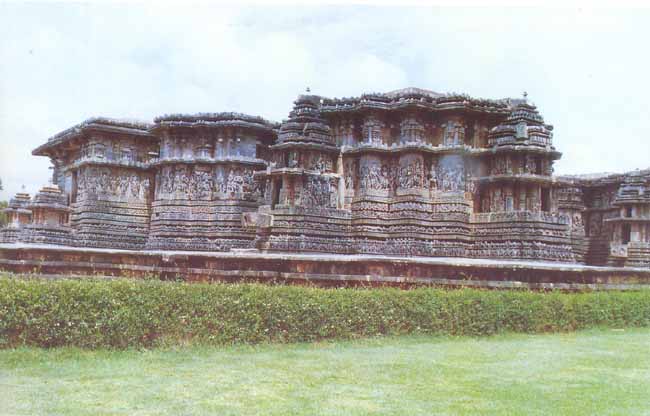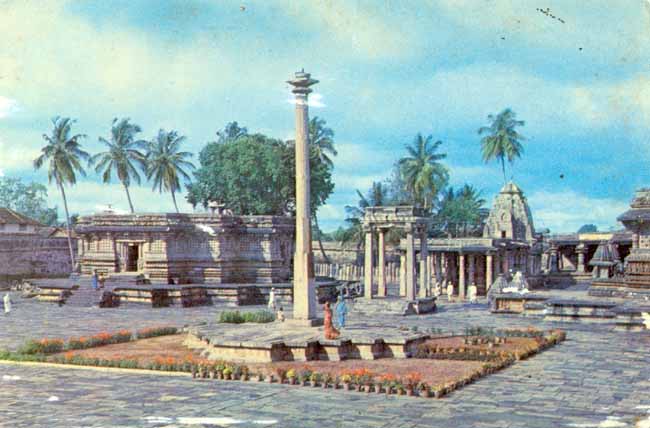
|
|
HOYSALA ARCHITECTURE
The Hoysala Rulers who succeeded the later Chalukyas and ruled over the Mysore Plateau in the 12th and 13th centuries A.D. were also lovers of art. They evolved a new style of architecture. The most notable temples of this period are those constructed in Belur, Halebid and Somnathpur. These temples are star-shaped. They are built on a high star-shaped base which is richly carved. The shikharas though pyramidal are low unlike those of other temples.
The Somnathpur temple was built by Vinaditya Ballal in about 1043 A.D. and is the earliest of this type. The temple though small was exquisitely carved with three pyramidal vimanas surmounting the three shrines. The best specimen of Hoysala art is the Hoysaleswara temple at Halebid and the Chenna Kesava temple at Belur.
The Hoysaleswara temple is composed of two similar temples side by side on a single five feet high star shaped terrace. Built of grey soap-stone, best suited for fine carving, each of the temples has star shaped vimanas with projections on three sides. The inner arms connect the two temples The mandapa ceilings and the pillars in the hall are intricately carved. The entire base is covered with running lengths of carved friezes of tigers, elephants, horses, birds and celestial beings-each frieze more beautiful than the other. The ceilings, interior and exterior walls of the temple have beautiful sculptures carved on them.

Hoysaleswara Temple Halebid
(Picture courtesy Archaeological Survey of India)
The Chenna Kesava temple at Belur was built by Vishnuvardhana of the Hoysala Dynasty in 1117 A.D. to commemorate a victory won over the Cholas at Talkad in 1116 A.D. It is dedicated to the deity Chenna Kesava. The temple stands in a spacious courtyard surrounded by a covered passage and compound with a gopura entrance. Later, other small temples were built in the courtyard around the main temple. The whole complex stands on a wide, raised star-shaped terrace with space enough for circumambulation. The star-shaped base has elephants in different poses adorning it The basement of the vimana is profusely carved with narrative friezes from the Ramayana, Mahabharata and Bhagavat Purana. The walls are covered with sculptures of miniature shrines, animated female figures and animals. The main entrances have a flight of steps from the courtyard and are flanked by two small vimanas. The ceiling and the pillars inside are elegantly carved. Bracket figures support the base of the ceiling: The superstructure on the main vimana is lost. Inside the sanctum sanctorum is the beautiful 2 meter high idol of Chenna Kesava.

Chenna Kesava temple, Belur
(Picture courtesy Archaeological Survey of India)
The Ganga rulers whose kingdom included Mysore have left behind a group of stone Jain temples on the hills of Chandrigiri and Vindyagiri at Sravanabelgola in Hassan district of Karnataka. The most impressive of the monuments is the statue of Bahubali or Gomateswara, a Jain prince who after a victory in battle renounced worldly life for a life of meditation. Carved out of massive granite, the statue stands on the crest of the Vindyagiri hill. Standing nearly 20 meres high from head to foot, is of perfect proportions. It was erected by Chamundaraya, a minister of the Ganga ruler, Rachamalla in 974-984 A.D. The creepers entwining the limbs of the show him completely oblivious of life around. The statue is surrounded by a granite pillared cloister built by Gangaraja, a minister of the Hoysala ruler Vishnuvardhana.
|
|